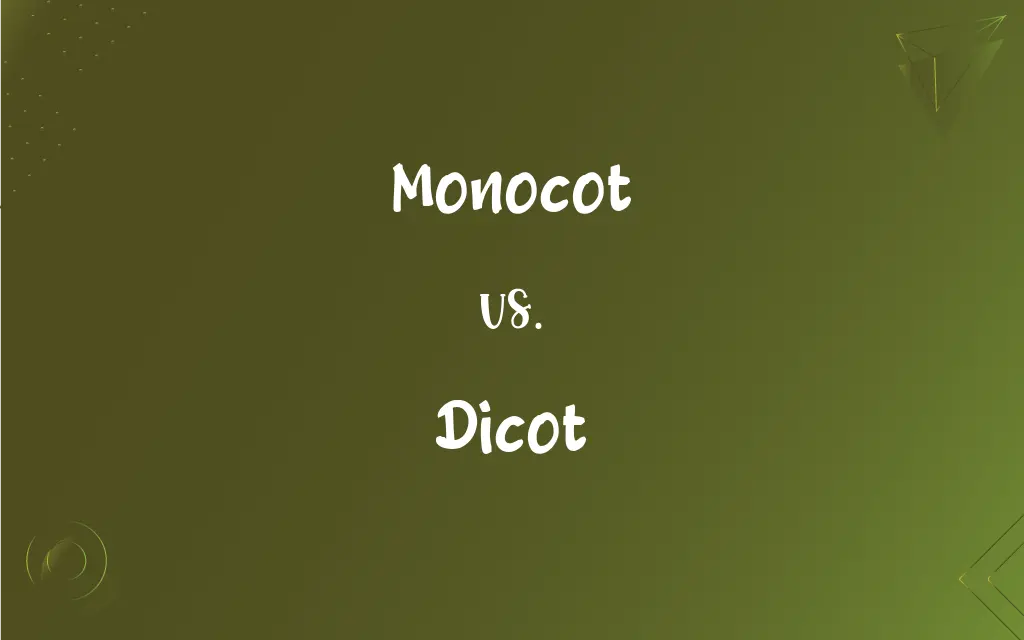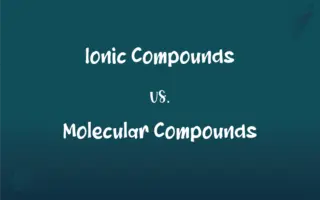Monocot vs. Dicot: What's the Difference?
Edited by Aimie Carlson || By Harlon Moss || Updated on June 7, 2024
Monocots have a single cotyledon in their seeds and parallel-veined leaves, while dicots have two cotyledons and leaves with a branched vein pattern.

Key Differences
Monocots and dicots are terms that describe two primary groups of angiosperms, or flowering plants, distinguished mainly by the number of cotyledons (seed leaves) they possess. Monocots, or monocotyledons, have a single cotyledon within their seed. Dicots, or dicotyledons, in contrast, contain two cotyledons in their seeds. These seeds tend to be larger and can be readily split into two halves, like that of a bean. Dicots include a wide variety of plants such as sunflowers, beans, and roses.
In the realm of root development, monocots and dicots also exhibit variances. Monocots typically develop a fibrous root system, which involves a cluster of roots that are about the same size, providing a secure hold on the soil. This fibrous root system doesn’t penetrate as deeply into the soil, yet it provides a robust network of roots that utilize nutrients from the upper soil layers efficiently.
Dicots, alternatively, generally develop a taproot system, where one primary root becomes more dominant and grows larger and stronger, burrowing deeper into the soil. The taproot often has smaller lateral roots extending from it. This system allows dicots to access water and nutrients from deeper soil layers, giving them a certain advantage in drier environments.
Floral structure presents another key point of difference between monocots and dicots. Monocots tend to have floral parts (like petals, sepals, and stamen) in multiples of three. They might have three or six petals, for instance. Dicots, however, typically display floral parts in multiples of four or five. Such distinctions in the floral organization offer a noticeable visual difference between the two groups, aiding in easier classification and identification for botanists and enthusiasts alike.
Comparison Chart
Cotyledons
One
Two
ADVERTISEMENT
Leaf Veins
Parallel
Branched/Net-like
Root System
Fibrous
Taproot
Floral Parts
In multiples of three
In multiples of four or five
Vascular Bundles
Scattered
Arranged in a circle
Monocot and Dicot Definitions
Monocot
In monocots, the leaves usually exhibit parallel venation.
The banana plant, a monocot, features leaves with distinct parallel veins.
ADVERTISEMENT
Dicot
Dicots are flowering plants that produce seeds with two cotyledons.
Beans are dicots, as they have seeds that split into two sections.
Monocot
Monocots are flowering plants with seeds that contain a single cotyledon.
Corn is a classic example of a monocot, possessing a single cotyledon within its seed.
Dicot
The leaf veins in dicots typically exhibit a branched pattern.
Oak trees, dicots, showcase a net-like vein pattern on their leaves.
Monocot
The floral parts of monocots generally occur in multiples of three.
Tulips, as monocots, display their floral parts, such as petals, in groups of three.
Dicot
Dicots usually present a taproot system, with one main root from which smaller lateral roots emerge.
The carrot, a dicot, forms a substantial taproot which is edible.
Monocot
Monocots typically possess a fibrous root system, providing a dense network of roots.
Rice plants, being monocots, showcase a fibrous root system that helps prevent soil erosion.
Dicot
In dicots, vascular bundles are characteristically arranged in a circle in the stem.
A cross-section of a sunflower stem, a dicot, reveals circularly arranged vascular bundles.
Monocot
Monocots exhibit scattered vascular bundles across their stem section.
The onion, a monocot, reveals scattered vascular bundles when its stem is viewed in cross-section.
Dicot
Floral parts of dicots are most often found in multiples of four or five.
Apples, which are dicots, blossom flowers that have five petals.
Monocot
Any of various flowering plants, such as grasses, lilies, and palms, having a single cotyledon in the seed, and usually a combination of other characteristics, typically leaves with parallel veins, a lack of secondary growth, and flower parts in multiples of three.
Dicot
Any of various flowering plants that are not monocotyledons, having two cotyledons in the seed and usually flower parts in multiples of four or five, leaves with reticulate venation, pollen with three pores, and the capacity for secondary growth. The dicotyledons, which include the eudicotyledons and the magnoliids, are no longer considered to form a single valid taxonomic group.
Monocot
(botany) monocotyledon
Dicot
(botany) A plant whose seedlings have two cotyledons, a dicotyledon.
Monocot
A monocotyledonous flowering plant; the stem grows by deposits on its inside
Dicot
Same as dicotyledon.
Dicot
Flowering plant with two cotyledons; the stem grows by deposit on its outside
FAQs
Can dicots exhibit parallel leaf venation?
While most dicots exhibit net-like venation, there are exceptions with parallel venation.
What is a monocot?
A monocot is a type of flowering plant with one cotyledon in its seed.
Are monocots and dicots scientifically classified groups?
Yes, they are broad groups classified based on several structural characteristics.
Are grasses typically monocots or dicots?
Grasses are typically monocots.
How can I recognize a dicot?
Dicots typically have two cotyledons, net-like leaf venation, and floral parts in multiples of four or five.
Do dicots always have floral parts in multiples of five?
Not always, dicots can have floral parts in multiples of four or five.
Do monocots have a taproot system?
No, monocots generally have a fibrous root system.
What are some examples of monocots?
Lilies, orchids, and grasses are examples of monocots.
What is an example of a dicot?
Roses are a common example of dicots.
Are monocots more common than dicots?
No, dicots are more prevalent, with over 170,000 species, while monocots have about 60,000.
Can monocots and dicots crossbreed?
It’s extremely rare, given the significant biological and structural differences.
How is the vascular tissue arranged in monocot stems?
Monocots have scattered vascular bundles in their stems.
What is the main difference in the seeds of monocots and dicots?
Monocots have one cotyledon in their seeds, while dicots have two.
Can the leaf venation be used to reliably classify monocots and dicots?
Leaf venation is a general guideline but is not foolproof due to exceptions.
Can a plant be neither a monocot nor a dicot?
Yes, there are other plant groups, but most flowering plants are classified as either monocot or dicot.
Is the number of floral parts a reliable method to differentiate between monocots and dicots?
Generally yes, but there are exceptions where plants may not follow the typical pattern.
In what environments do monocots typically thrive?
Monocots are versatile and can be found in various environments, from deserts to wetlands.
Why is the distinction between monocots and dicots significant in botany?
Understanding these categories helps botanists classify, study, and understand plant evolutionary and adaptive strategies.
Are there plants that are more evolutionarily advanced: monocots or dicots?
Neither is considered more advanced; they simply have different evolutionary adaptations.
Do all dicots exhibit a taproot system?
While most dicots have a taproot system, there are always exceptions in biology.
About Author
Written by
Harlon MossHarlon is a seasoned quality moderator and accomplished content writer for Difference Wiki. An alumnus of the prestigious University of California, he earned his degree in Computer Science. Leveraging his academic background, Harlon brings a meticulous and informed perspective to his work, ensuring content accuracy and excellence.
Edited by
Aimie CarlsonAimie Carlson, holding a master's degree in English literature, is a fervent English language enthusiast. She lends her writing talents to Difference Wiki, a prominent website that specializes in comparisons, offering readers insightful analyses that both captivate and inform.































































